Menus
- How good is the new Gixxer?
- Video of the driving report of the new Suzuki GSX-R 1000 R.
- The sea shines azure blue in the background
- Transmission can be shifted easily and precisely
- Series tires on the racetrack are not very convincing
- Enough options for individual settings
- Left to right and left again
- There are reserves for fine adjustments
- Brakes are energetic and easy to adjust
- Price is an announcement
- Technical data Suzuki GSX-R 1000 R
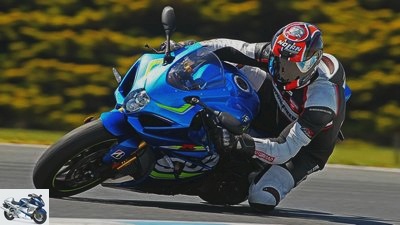
Suzuki
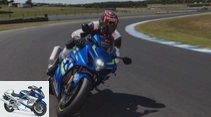

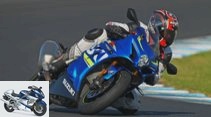
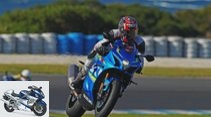
27 photos

Suzuki
1/27
Suzuki GSX-R 1000 R.
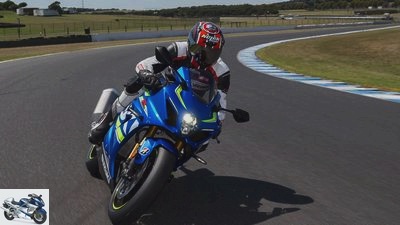
Suzuki
2/27
Suzuki GSX-R 1000 R.
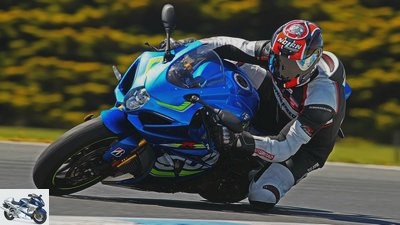
Suzuki
3/27
Suzuki GSX-R 1000 R
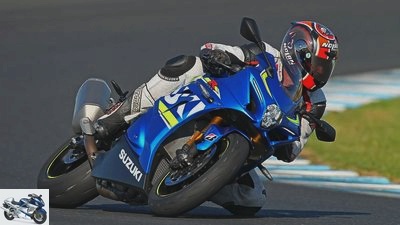
Suzuki
4/27
Suzuki GSX-R 1000 R.
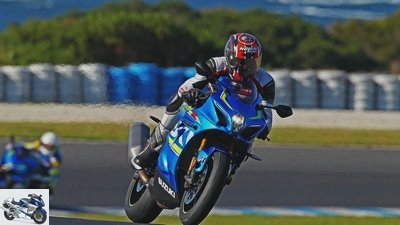
Suzuki
5/27
Suzuki GSX-R 1000 R.
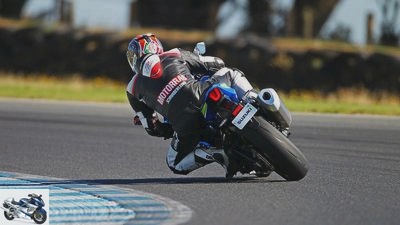
Suzuki
6/27
Suzuki GSX-R 1000 R.
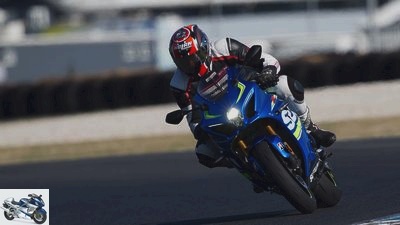
Suzuki
7/27
Suzuki GSX-R 1000 R.
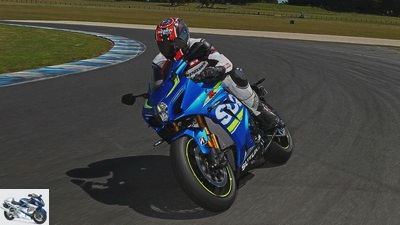
Suzuki
8/27
Suzuki GSX-R 1000 R.
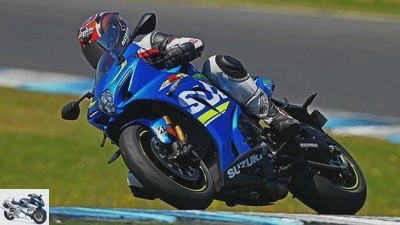
Suzuki
9/27
After “Lukey Heights”: First pull further to the right, then quickly fold over.
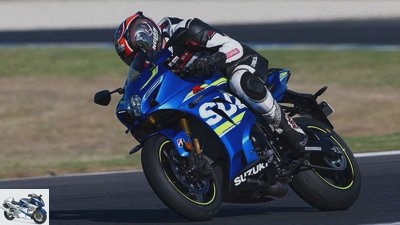
Suzuki
10/27
Suzuki GSX-R 1000 R.
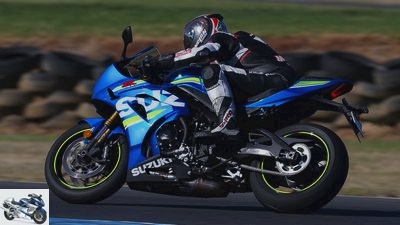
Suzuki
11/27
Suzuki GSX-R 1000 R.
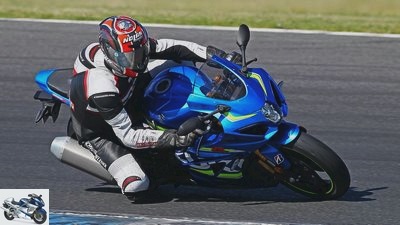
Suzuki
12/27
Suzuki GSX-R 1000 R.
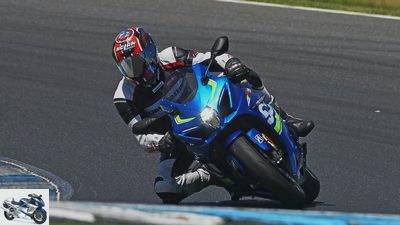
Suzuki
13/27
Suzuki GSX-R 1000 R.
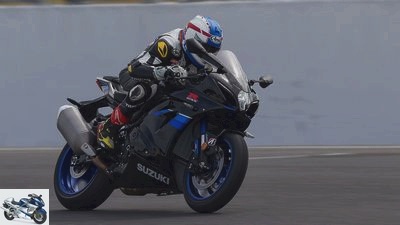
Suzuki
14/27
Suzuki ambassador Kevin Schwantz demonstrated the black and blue version of the GSX-R
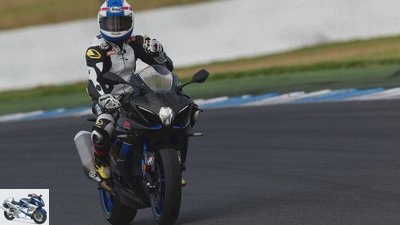
Suzuki
15/27
Suzuki GSX-R 1000 R.
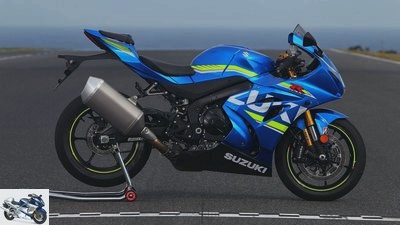
Suzuki
16/27
This photo not only shows the GSX-R 1000 R in all its glory, but also gives an impression of the driver’s perspective before the free fall down to the “Doohan Corner”
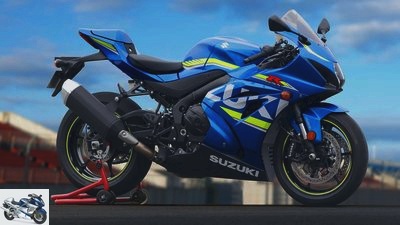
Suzuki
17/27
Suzuki GSX-R 1000 R.
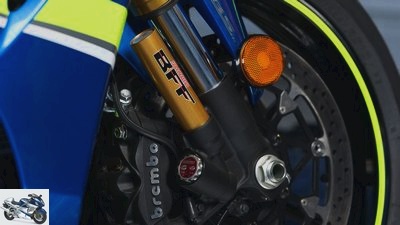
Suzuki
18/27
The balance-free suspension elements from Showa are only available in the R version of the new Gixxer.
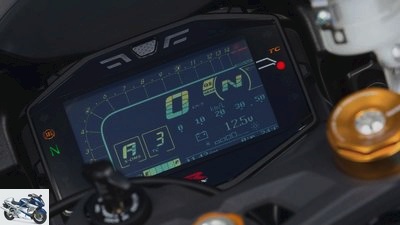
Suzuki
19/27
The most important thing for the racetrack – the display of the gearshift speed – the driver sees immediately where the others are, he has to learn.

Suzuki
20/27
The LED rear light was integrated form-fittingly into the rear.
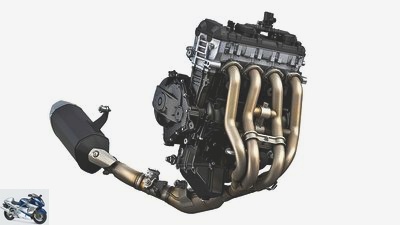
Suzuki
21/27
Elaborate Gixxer exhaust: three flaps support the gas change. Cylinders one and four as well as two and three are interconnected, the third flap sits as usual behind the collector.
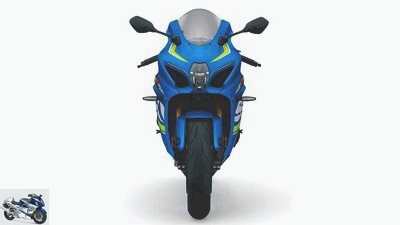
Suzuki
22/27
Suzuki GSX-R 1000 R.
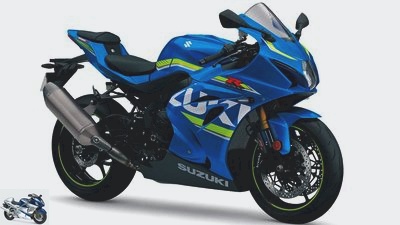
Suzuki
23/27
Suzuki GSX-R 1000 R.
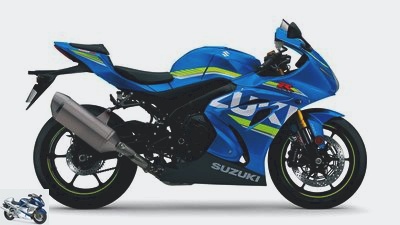
Suzuki
24/27
Suzuki GSX-R 1000 R.
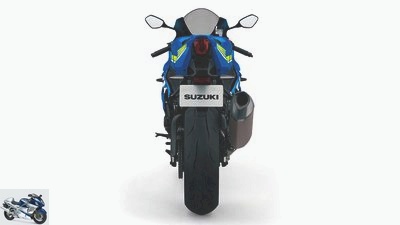
Suzuki
25/27
Suzuki GSX-R 1000 R.
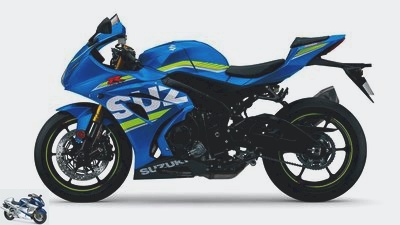
Suzuki
26/27
Suzuki GSX-R 1000 R.
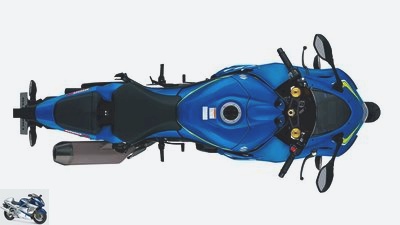
Suzuki
27/27
Suzuki GSX-R 1000 R.
Suzuki GSX-R 1000 R in the driving report
How good is the new Gixxer?
The Suzuki GSX-R 1000 R is the first 200 hp super sports car with variable valve control. How does the new Gixxer drive?
The importance of a new superbike and the confidence of its manufacturer can be seen from where it is presented. This is the yardstick for the Suzuki GSX-R 1000 R is extremely important, and its developers are extremely confident. The reason: It was presented on the legendary Phillip Island circuit, one of the most difficult and spectacular courses there is. First impression after a few laps: the engine is powerful. It has been completely redesigned, is lighter and more compact due to the waiver of the balancer shaft of the previous 1000 series Gixxer and, thanks to the valve actuation via delicate rocker arms, offers the best conditions for high-performance valve timing. So that this does not result in a racing engine with sharp characteristics, the intake camshaft was given a drive wheel which, actuated by centrifugal force, shifts the intake timing. In the middle speed range this should bring more torque, and at the top the peak performance should benefit. The engine developers did an excellent job.
Buy complete article
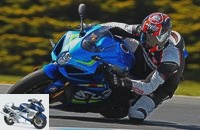
Suzuki GSX-R 1000 R in the driving report
How good is the new Gixxer?
Four-cylinder exudes enormous pressure
The driver does not notice this shift. He only feels the enormous pressure that the new four-cylinder Suzuki GSX-R 1000 R is building up in the upper middle. He does this particularly impressively in the last corner of the Phillip Island Circuit. Without wanting to tell heroic stories, the author asks the reader to put themselves in the following situation: left turn, fourth gear, about 180 km / h, full lean angle. With a slight elevation of the road, it first goes a little downhill, then from a shallow depression towards the home straight. The curbs on the right-hand side of the lane can only be seen so late that you can hardly tell whether you will hit them or get off the track.
Video of the driving report of the new Suzuki GSX-R 1000 R.
The sea shines azure blue in the background
Once the line is under control and the power is released, you see yourself catapulted onto the flat part of the home straight with such vehemence that you are only a passenger behind the handlebars of the Suzuki GSX-R 1000 R for a few seconds. It takes a lot of strength to push yourself forward against the acceleration. Fifth gear, towards the end of the row of pits, the sixth, then it goes down another ledge to the “Doohan Corner”. The sea shines azure blue in the background. The high-speed tunnel vision condenses its sight, idyll reigns for a millisecond, then the view lowers on the route, briefly brushes over the speedometer. Around 280 km / h, the Doohan Corner is approaching. Oh oh! Brake late – it was usually too early -, flip down two gears – it’s nice how quickly and easily it happens – and dive into the far right curve at breathtaking speed. You feel incredibly fast, you are always too slow and you realize that a normal mortal can hardly cope with more MotoGP feeling.
Transmission can be shifted easily and precisely
When the exertion and excitement subside a little after the first driving session, you realize how well the fairing of the new GSX-R protects its pilot from the headwinds. The memory also confirms how easily and precisely the transmission of the Suzuki GSX-R 1000 R can be shifted. No matter whether with shift assistant or clutch insert. The cable-operated clutch itself requires little manual force, and its anti-hopping function is discreet and reliable. When downshifting from third to second gear in front of the so-called Siberia hairpin – for testing without the blipper function of the shift assistant and therefore without throttle – the hindquarters show a brief reaction. In view of the high speed at which the clutch is engaged here, the braking torque of the motor is smoothly ironed out.
Series tires on the racetrack are not very convincing
Unfortunately, those responsible for Suzuki insisted on running the first three 20-minute turns on production tires, a set of Bridgestone RS10 E. Due to the high temperatures and speeds as well as the long acceleration phases in the left-hand corners “Southern Loop”, “Siberia” and the double curve at the end, these poor tires were completely overheated by the second test session. The front tire gave a spongy feeling, in the middle of the bends even small bumps caused the Suzuki GSX-R 1000 R to slide over both wheels, and the rear tire produced rough and sudden slides when accelerating in an inclined position. Because of the supposedly wider limit range of the road tires, the technicians had set the traction control relatively sharp, at level three out of ten. In previous tests, the tires and this setting may have worked well together. The traction control was too late for the asphalt temperatures that were over ten degrees higher that day. The RS10 will probably work in the driving mode for which it was designed. In the heat and on this track, he had no chance to show his qualities.
Enough options for individual settings
Bridgestone R10 supersport racing tires coped much better with the conditions. They gave the front wheel the leadership qualities it needs to hit and hold the right line. And the rear tire was able to convert what was, for him, the extremely tiring combination of grippy asphalt and GSX-R power into vehement propulsion. According to the technicians’ logic at the limit, the traction control with the sharp racing tires was on the more defensive level five. Her work could be felt when accelerating from the apex, but she did not give the driver the feeling that he was braking too much. The fine gradation offers enough options for individual settings. As the description of the route’s character suggests, the GP course on Phillip Island shifts the benchmarks in terms of speed and thus also influences the perception of steering behavior. There are only two slow corners and only one of the two requires a jagged lean angle change from right to left. The Suzuki GSX-R 1000 R masters this with ease, but without tipping over.
Left to right and left again
She acts as a carrier on the approach to “Lukey Heights”. Before the route winds towards the famous hilltop in a left curve, it is necessary to turn from left to right and back to left, which requires a few pulls on the handlebars and energetic repositioning of the driver with constant acceleration between an estimated 160 and around 200 km / h . This does not detract from the fascination of the fast “Esses” at full inclination, it just has to be bought with committed physical effort. This observation was confirmed from a qualified mouth: Kevin Schwantz circled the track as an observer of the journalists, followed the author for two polite tours and said during the chat that followed: “The first time I am the new Suzuki GSX-R 1000 R on the riverside I drove to the Raceway in California, where it seemed incredibly handy. At the pace here, I have to think about this statement again. “
There are reserves for fine adjustments
Although its frame profiles are more delicate than the competition and despite a rather short lag, the GSX-R remained very stable in the fast passages. The long swing arm and the extended wheelbase apparently bring the chassis geometry to the stable side of the spectrum. Where it lines up in comparison to the competition and on a “normal” racetrack, MOTORRAD will drive out at the next opportunity. After the Kawasaki ZX-10R, the GSX-R 1000 R also received the latest generation of Showa suspension elements. They responded very delicately, but had to be tightened in the damping – which is more demanded by the racing tires and the higher speed. In the front especially in the compression stage, in the rear rather in the rebound stage. With just under two turns from the fully closed position, the Suzuki GSX-R 1000 R already felt promising. So there are still reserves for fine adjustments.
Brakes are energetic and easy to adjust
When braking hard on the slow Honda, sorry, Suzuki corner, the fork compresses deeply relatively quickly. Tests with the spring preload are likely to be pending in a tough comparative race track test. The brakes of the Suzuki GSX-R 1000 R showed themselves to withstand the tough loads at the end of the home straight and in front of the Honda corner, their effect developed slightly progressively. Overall, the friction pairing acts energetically and easily metered. In the course of the day there was a slightly delayed response, which could also be determined with the Nissin ABS switched off. In relation to the various irregularities that occurred during the last MOTORRAD track test (8/2016) in terms of brakes, this shift was relatively insignificant.
Price is an announcement
In summary, the engine of the new Suzuki GSX-R 1000 R, the wonderfully shiftable gearbox and the smooth drive train make the strongest impression. Despite all the necessary reservations about hasty comparisons, your chassis is more likely to be classified on the stable side, the brakes and electronics correspond to the current, already extremely high standard. Fortunately, the price makes the exception: for 18,990 euros, the R model offers upscale equipment with a shift assistant in both directions, ABS that can be switched off, lean angle, traction and wheelie control as well as race start assistant – driving aids, all of which come from a Bosch IMU the necessary data are supplied. It is thus below the other R or SP models, but unlike the Honda Fireblade SP, the BMW S 1000 RR or the Yamaha R1 M, it is not available with a semi-active chassis. Nevertheless: the price is also an announcement.
Technical data Suzuki GSX-R 1000 R
Suzuki GSX-R 1000 R
engine
Water-cooled four-cylinder four-stroke in-line engine, two overhead, chain-driven camshafts, four valves per cylinder, rocker arms, wet sump lubrication, injection, 4x Ø 46 mm, regulated catalytic converter with secondary air system, mechanically operated multi-disc oil bath clutch (anti-hopping), six-speed gearbox, O-ring Chain, secondary gear ratio 2.647.
Bore x stroke: 76.0 x 55.1 mm
Displacement: 1000 cc
Compression ratio: 13.2: 1
Rated capacity: 149.0 kW (203 hp) at 13,200 rpm
Max. Torque: 118 Nm at 10,800 rpm
landing gear
Bridge frame made of aluminum, upside-down fork, Ø 43 mm, electro-hydraulic steering damper, adjustable spring base, rebound and compression damping, two-arm swing arm with upper pulls made of aluminum, central spring strut with lever system, adjustable spring base, double disc brake at the front, Ø 320 mm, four-piston fixed calipers, disc brake rear, Ø 220 mm, single-piston floating caliper, traction control, ABS.
Cast aluminum wheels: 3.50 x 17; 6.00 x 17
Tires: 120/70 ZR 17; 190/55 ZR 17
Dimensions + weights
Wheelbase 1420 mm, steering head angle 66.8 degrees, caster 95 mm, suspension travel n / a, seat height 825 mm, empty weight 203 kg, permissible total weight 390 kg, tank capacity 16.0 liters.
Guarantee: two years
Colours: blue
Price: 18,990 euros
Additional costs: 250 euro
Related articles
-
Endurance test final balance Suzuki GSX-R 1000
Jelicic, Bilski, Koch, Sdun 30 pictures Suzuki 1/30 Suzuki 2/30 Suzuki 3/30 Suzuki 4/30 Suzuki 5/30 Suzuki 6/30 Suzuki 7/30 Suzuki 8/30 Suzuki 9/30 Suzuki …
-
Driving report Honda VTR 1000 time shift Japan is eight hours ahead of Germany, Honda is four weeks behind Suzuki – at least when it comes to the first…
-
Suzuki Premiere, Suzuki GSX-R 1000 Suzuki GSX-R 1000 already driven Content of Suzuki briefly accelerates. Before the big model change, the Japanese…
-
Suzuki V-Strom 650 XT in the driving report
Suzuki 11 pictures Suzuki 1/11 Suzuki V-Strom 650 XT Suzuki 2/11 Suzuki V-Strom 650 XT Suzuki 3/11 No question, in comparison the new 650 XT looks more modern …
-
Kawasaki Versys 1000 driving report
Wright driving report: Kawasaki Versys 1000 (with video) Kawasaki’s all-rounder now with a large four-cylinder No half measures: For the Versys there is now the …
-
Honda Fireblade vs. Suzuki GSX-R 1000 in comparison test
Maccabelli The last four-cylinder without control electronics Test: Honda Fireblade against Suzuki GSX-R 1000 Contents of They are the last current …
-
Driving report Honda CRF 1000 L Africa Twin (part 1)
Honda 13 photos ULA SERRA PRATS 1/13 Honda Africa Twin. 2/13 270 degree crank pin offset, long, continuous shaft with two balance weights in front of the…
-
Suzuki GSX-R 1000 R in the PS driving report
Suzuki 14th photos Suzuki 1/14 With the 2017 version, the GSX-R 1000 enters the sixth generation. The superbike was launched for the first time in 2001,…
-
Driving report Suzuki TL 1000 S
Driving report, Suzuki TL 1000 S Suzuki TL 1000 S. The TL 1000 S is intended to break the Italian supremacy among large-volume two-cylinder engines and…
-
BMW S 1000 R in the driving report
36 pictures 1/36 2/36 3/36 4/36 5/36 The headlights on this BMW also shine asymmetrically. 6/36 The standard steering damper is not …